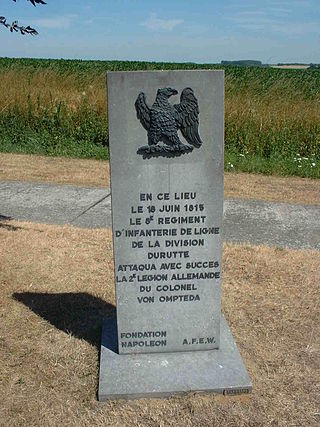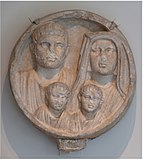
Mummy portraits or Fayum mummy portraits are a type of naturalistic painted portrait on wooden boards attached to upper class mummies from Roman Egypt. They belong to the tradition of panel painting, one of the most highly regarded forms of art in the Classical world. The Fayum portraits are the only large body of art from that tradition to have survived. They were formerly, and incorrectly, called Coptic portraits.

A stele, or occasionally stela when derived from Latin, is a stone or wooden slab, generally taller than it is wide, erected in the ancient world as a monument. The surface of the stele often has text, ornamentation, or both. These may be inscribed, carved in relief, or painted.

The study of Roman sculpture is complicated by its relation to Greek sculpture. Many examples of even the most famous Greek sculptures, such as the Apollo Belvedere and Barberini Faun, are known only from Roman Imperial or Hellenistic "copies". At one time, this imitation was taken by art historians as indicating a narrowness of the Roman artistic imagination, but, in the late 20th century, Roman art began to be reevaluated on its own terms: some impressions of the nature of Greek sculpture may in fact be based on Roman artistry.

The tomb of Marcus Vergilius Eurysaces the baker is one of the largest and best-preserved freedman funerary monuments in Rome. Its sculpted frieze is a classic example of the "plebeian style" in Roman sculpture. Eurysaces built the tomb for himself and perhaps also his wife Atistia around the end of the Republic. Located in a prominent position just outside today's Porta Maggiore, the tomb was transformed by its incorporation into the Aurelian Wall; a tower subsequently erected by Honorius covered the tomb, the remains of which were exposed upon its removal by Gregory XVI in 1838. What is particularly significant about this extravagant tomb is that it was built by a freedman, a former slave.

Etruscan art was produced by the Etruscan civilization in central Italy between the 10th and 1st centuries BC. From around 750 BC it was heavily influenced by Greek art, which was imported by the Etruscans, but always retained distinct characteristics. Particularly strong in this tradition were figurative sculpture in terracotta, wall-painting and metalworking especially in bronze. Jewellery and engraved gems of high quality were produced.

Roman portraiture was one of the most significant periods in the development of portrait art. The surviving portraits of individuals are almost entirely sculptures, covering a period of almost five centuries. Roman portraiture is characterised by unusual realism and the desire to convey images of nature in the high quality style often seen in ancient Roman art. Some busts even seem to show clinical signs. Several images and statues made in marble and bronze have survived in small numbers. Roman funerary art includes many portraits such as married couple funerary reliefs, which were most often made for wealthy freedmen rather than the patrician elite.

Hairstyle fashion in Rome was ever changing, and particularly in the Roman Imperial Period there were a number of different ways to style hair. As with clothes, there were several hairstyles that were limited to certain people in ancient society. Styles are so distinctive they allow scholars today to create a chronology of Roman portraiture and art; we are able to date pictures of the empresses on coins or identify busts depending on their hairstyles.

The gens Antistia, sometimes written Antestia on coins, was a plebeian family at ancient Rome. The first of the gens to achieve prominence was Sextus Antistius, tribune of the plebs in 422 BC.

The Grave Stele of Hegeso, most likely sculpted by Callimachus, is renowned as one of the finest Attic grave stelae surviving today. Dated from c. 410 – c. 400 BCE, it is made entirely of Pentelic marble. It stands 1.49m high and 0.92m wide, in the form of a naiskos, with pilasters and a pediment featuring palmette acroteria. The relief, currently on display at the National Archaeological Museum in Athens was found in 1870 in the Kerameikos in Athens, which now houses a replica of it.

The funerary art of ancient Rome changed throughout the course of the Roman Republic and the Empire and took many different forms. There were two main burial practices used by the Romans throughout history, one being cremation, another inhumation. The vessels used for these practices include sarcophagi, ash chests, urns, and altars. In addition to these, mausoleums, stele, and other monuments were also used to commemorate the dead. The method by which Romans were memorialized was determined by social class, religion, and other factors. While monuments to the dead were constructed within Roman cities, the remains themselves were interred outside the cities.

Palmyrene funerary reliefs are almost 4,000 busts on decorative slabs closing burial niches inside underground tombs, produced in Palmyra over three centuries from the middle of the first century BC. It is the largest corpus of portrait sculpture in the Roman world outside Rome and the largest collection of funerary representations from one place in the classical world.
The gens Matrinia was a plebeian family at Rome. Members of this gens are first mentioned toward the end of the second century BC. They belonged to the equestrian class. Several of them are known through the writings of Cicero, while others are mentioned in inscriptions from Umbria and Etruria.

The gens Rennia, occasionally written Renia, was an obscure plebeian family at ancient Rome. No members of this gens obtained any of the higher offices of the Roman state, but the family is known from inscriptions, and coins issued by a certain Gaius Renius, depicting the head of Roma on the obverse, and on the reverse Juno Caprotina in a chariot pulled by two goats.
The gens Safinia was a minor plebeian family at ancient Rome. Few members of this gens are mentioned in history, but a number are known from inscriptions.

The Lapidary Museum is a lapidarium-museum in Avignon, France. It has housed the classical Greek, Etruscan, Roman and Gallo-Roman sculptures and objects of the Calvet Museum since the 1980s. They are both run by the Fondation Calvet. As well as exhibiting the museum's core collections, it also mounts summer temporary exhibitions, conferences and networking events, particularly for scholars.
The gens Seppia was an obscure plebeian family at ancient Rome. Few members of this gens appear in history, but many are known from inscriptions.
The gens Septicia was an obscure plebeian family at ancient Rome. Hardly any members of this gens are mentioned in ancient writers, but a number are known from inscriptions. The most famous of the Septicii was Gaius Septicius Clarus, Prefect of the Praetorian Guard under the emperor Hadrian.
The gens Trebulana, occasionally spelled Treblana, was an obscure plebeian family at ancient Rome. No members of this gens are mentioned by Roman writers, but several are known from inscriptions, and at least one attained high office under the early Empire, as Publius Trebulanus was praetor urbanus in AD 30.
The gens Umbricia was a minor plebeian family at ancient Rome. Only a few members of this gens are mentioned by Roman writers, but they had achieved senatorial rank by the second century. The most famous of the Umbricii are probably the haruspex Gaius Umbricius Melior, who served the emperors of the middle first century, and Aulus Umbricius Scaurus, a merchant of Pompeii whose fish sauces were widely distributed. Quintus Umbricius Proculus was a second-century governor of Hispania Citerior. Many other Umbricii are known from inscriptions.

The Tomb of the Haterii is an Ancient Roman funerary monument, constructed between c. 100 and c. 120 CE along the Via Labicana to the south-east of Rome. It was discovered in 1848 and is particularly noted for the numerous artworks, particularly reliefs, found within.






















